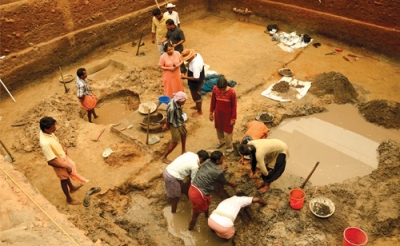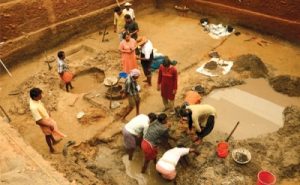
Hyderabad, April 28 (IANS) The archeological site at Pattanam, on the south-western coast of the Indian subcontinent in Kerala’s Ernakulam district, is believed be part of the ancient port city of Muziris.
Historians consider the city of Pattanam to have played an instrumental role in trade and cultural exchanges between India and the Middle East, North Africa and the Mediterranean regions.
The belief stems from the classical Greco-Roman records as well as Tamil and Sanskrit sources. The recent and more conclusive archeological evidences from Pattanam, and their ancient DNA analyses led by Dr Kumaraswamy Thangaraj and Dr P.J. Cherian strengthen the belief, and their research is now published in the journal, Genes.
At the Pattanam archeological site, scientists and archeaologists have found human bones, storage jars, a gold ornament, glass beads, stone beads, utilitarian objects made of stone, copper, and iron, pottery, early Chera coins, brick wall, brick platform, ring well, wharf with bollards and a six meter long wooden canoe parallel to the wharf structure about 2.5 meter below surface level.
“These structures indicate a vast urban settlement. The excavations suggest that the site was first occupied by the ingenious ‘Megalithic’ (Iron Age) people, followed by the Roman contact in the early historic period. It appears that the site was continuously occupied at least from the 2nd century BC to the 10th century AD,” said Dr Cherian, from PAMA Institute for the Advancement of Transdisciplinary Archeological Sciences, Ernakulam.
Scientists used the DNA from human skeletons to pinpoint the generic ancestry of the people found in the region.
Dr Niraj Rai, co-corresponding author of the paper and a senior scientist, DST-Birbal Sahni Institute of Palaeosciences, Lucknow said: “We have analysed the mitochondrial DNA of 12 ancient skeletal samples. We found that these samples show the presence of both South Asian and West Eurasian-specific lineages.”
The harsh climatic conditions of India are not always favorable to ancient DNA research. “Most of the excavated skeletal remains from the Pattanam site were in a very fragile state due to tropical, humid, and acidic soil conditions. However, we have adopted the best practices in the field of ancient DNA and successfully analysed the samples. The unique imprint of West Eurasian and Mediterranean signatures found in these samples exemplify a continuous inflow of trades and multicultural mixing in ancient South India,” said Dr Thangaraj, chief scientist at CSIR-Centre for Cellular and Molecular Biology (CCMB) and currently the director, DBT-Centre for DNA Fingerprinting and Diagnostics.
“This is the first genetic data generated, so far, to infer the origin and genetic makeup of Pattanam archeological site. And the findings reinforce the early historical occupation of culturally, religiously and ethnically diverse groups at the Pattanam Archeological site,” said Dr Vinay Kumar Nandicoori, Director, CCMB.
–IANS
ms/vd










